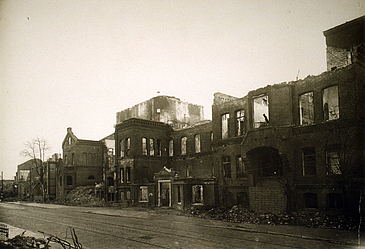Former bunkers from the Second World War are not uncommon in Bremen’s townscape, and yet very few people know about the background of these buildings. The high-rise bunker in Walle, which features murals of people looking through binoculars, is well-known; its history, however, is not. This bunker has a very special background: it was not only a hospital built of concrete, but was also converted into a nuclear bunker in the 1960s. For some years now, the Bremen Zuckernetzwerk has been trying to acquire the currently unused bunker as a location to open a cultural club. The accompanying media discussion still does not cover the history of the bunker sufficiently.
Practical Historical Work at the University
For two semesters since October 2017, history students at the University of Bremen, under the direction of Dr. Sonja Kinzler, have been conducting scientific research into the eventful history of the bunker for the first time. At the Kulturbunker, they are now presenting an exhibition that sheds light on the construction of the building, the subject of forced labor, hospital operations during the war, and post-war uses. To implement the project, they are cooperating with the Zuckernetzwerk and the Kultur im Bunker association. Students from the University of the Arts Bremen (HfK Bremen) have developed the design concept for the exhibition and will contribute their own works.
Bunker Construction Part of Nazi History
During their research work in various institutions such as the state archives, the students discovered construction plans, photographs, and interviews that reveal the significance of the bunker as a monument of war, a refuge, a place of exclusion, fear, and help. “The bunker is part of the history of Nazism. It is therefore essential to review its history of origin and use, and to incorporate the scientific findings on it into the current debate on its future use,” says history lecturer Sonja Kinzler. “Even if the use of forced laborers was difficult to understand due to the confusing historical situation and gaps in tradition, the students were able to find out which company carried out the construction and that they used forced laborers for it,” she explains. The students report that independent research on this extensive complex of topics and the implementation of the exhibition was a special experience.
The exhibition will open on Saturday, September 15, 2018, at 7 p.m. at the Kulturbunker, Berliner Strasse 22c, 28203 Bremen. Opening hours are Thursdays and Fridays from 3 p.m. to 7 p.m. and Saturdays from 10 a.m. to 3 p.m. Guided tours can be arranged on an individual basis. A closing event is planned for October 12 at 7 p.m.
Additional Information:
www.retrokonzepte.de/bunkerausstellung.html
www.uni-bremen.de
Contact:
Dr. Sonja Kinzler
Faculty of Social Sciences
University of Bremen
Tel.: +49-178-886-6666
E-mail: kinzlerprotect me ?!uni-bremenprotect me ?!.de
The students can be reached by sending an e-mail to:
ausstellungdiakonissenbunkerprotect me ?!webprotect me ?!.de

